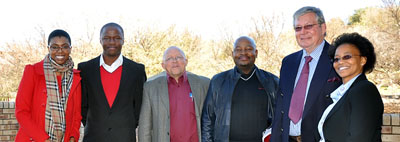 |
At the event were, from the left: Ms Bontle Senne, Managing Director for the PUKU Children’s Literature Foundation, Mr Sipho Hlongwane, writer and columnist for the Daily Maverick, Prof. Nicky Morgan, Vice-Rector: Operations at the UFS, Mr Themba Mola, Chief Operations Officer at Kagiso Trust, Mr Johann Naudé, son of Dr Beyers Naudé, and Dr Choice Makhetha, Vice-Rector: External Relations.
Photo: Stephen Collett
2 August 2012 |
The University of the Free State (UFS) together withKagiso Trust, presented the first Beyers Naudé lecture for 2012 on its South Campus in Bloemfontein last week. Speakers like Dr Wilmot James, Member of Parliament, Mr Johann Naudé, son of Dr Beyers Naudé, Mr Sipho Hlongwane, writer and columnist for the Daily Maverick and Ms Bontle Senne, Managing Director for the PUKU Children’s Literature Foundation, all gave a lecture around this year’s theme: Collaborative partnerships for social cohesion: Building a nation with ethics.
Dr Beyers Naudé played a major role in the formation of Kagiso Trust. His contribution to the trust and the fight against oppression in South Africa, as well as his challenging of the establishment from which he came, makes him one of South Africa’s courageous heroes. Kagiso Trust thus saw it fit to celebrate the life of this clerical activist through a Memorial Lecture The Beyers Naudé Memorial Lecture is an effort by the Trust to engage South Africans into a dialogue about issues affecting our nation.
Mr Johann Naudé talked about the lessons they as children learnt from their parents as well as his father’s decision to respond to the needs of the people in South Africa. Even before the Sharpeville Massacre, Dr Naudé began a self-transformation that led to his rejection of apartheid. “Apartheid had no theological or scriptural grounds and my father decided to resign from the church. After that, he started to talk openly against apartheid and he also paid the price for that. For seven years he was under house arrest and we as his children also felt the effect of his decision. At the University of Pretoria in a residence where I stayed as a student I was called in and told that I would be treated as an outcast. Loans and jobs were also closed for us as children and as a result, we all started our own businesses,” Mr Naudé said.
“Furthermore, our parents taught us to believe in ourselves. He also said we have rights and we can only demand those rights if we take the responsibility that goes with it. My father also taught us to honour and to respect our fellow men, elderly people and the culture of people different from us. We were also taught to apologise for the wrongs to our fellow men and to acknowledge earnestly that we were wrong.”
Dr Wilmot James said that there were two things consistent in the life of Dr Beyers Naudé, namely justice and fairness. “There are many Nelson Mandelas and Beyers Naudés out there. It is the responsibility of political parties and institutions to motivate such leadership. We must ask ourselves: Are my actions and decisions ethical and will they have fair consequences?” Dr James said.
Mr Hlongwane focused his presentation on the ethics part of the theme. He said: “We in South Africa fall very short of ethics. We can start by respecting each other and taking care of one another. The Constitution will not mean a thing if we fail to respect and trust one another. We will have no cohesive society if we continue to treat those different from us like dirt. It is also our ethical duty to build up the disadvantaged.
In her discussion, Ms Senne emphasised the role of the youth in South Africa. “Our youth is failing our state because our state is failing our youth. Their role is to bring cohesion and acts of courageousness to the table. For them to contribute in a practical and sustainable manner, they need to start making the changes they want to see in society. They are young people and they can make it work because they do have access to the necessary means (social networks) to get things done. They must get involved,” she said.